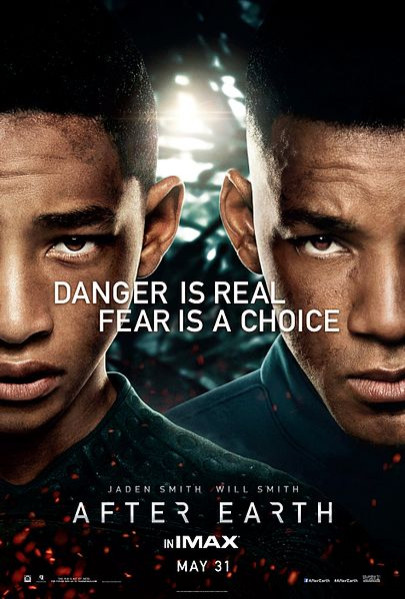Is 'After Earth' Actually Propaganda For The Church Of Scientology?

Will Smith’s post-apocalyptic would-be blockbuster “After Earth” was accorded a disastrous box-office and critical reception this weekend. By and large, critics and filmgoers appeared to think that “After Earth” is little more than a push to make Smith’s son Jaden Smith a star. But is there something else at work as well?
“After Earth” may be both a failed attempt to thrust Jaden Smith into the limelight and an elaborate piece of Scientology propaganda, according to multiple media accounts.
Will Smith has never publicly come out as a Scientologist, but the star has plenty of well-documented links to the religion. In 2007, Smith and his wife Jada Pinkett Smith donated $122,500 to various Scientology centers, FoxNews.com noted. In 2009, the couple founded the New Village Leadership Academy, a private elementary school in Calabasas, Calif., that uses Study Technology, a teaching methodology developed by Scientology creator L. Ron Hubbard, as pointed out by ABC News. The Smiths have made financial contributions to the school since then, as well. Will Smith may not be a practicing Scientologist himself, but he has claimed many of Scientology’s ideas are “brilliant” and he clearly has close ties to the religion.
What does that mean for “After Earth” and its own ties to Scientology? According to reviews by the New York Times, Vulture and Marc Headley, an ex-Scientologist writing in the Hollywood Reporter, “After Earth” is just dripping in the philosophy of Scientology. Let’s look at how.
Fear
In “After Earth,” Jaden Smith plays Kitai Raige, a space ranger who crash-lands on a post-apocalyptic Earth with his father, Gen. Cypher Raige. Kitai must traverse Earth’s hostile terrain to reach a homing beacon located in a volcano (more on that later). But for all the vicious, out-of-control flora and fauna, the main villain in “After Earth” appears to be fear itself. In fact, one species on the planet literally feeds on fear itself. By the end of the film, Kitai seems to have mastered his emotions like his almost robotic father.
One of the main goals of Scientology is teaching its followers to abandon supposedly harmful and unnecessary emotions such as fear. As members progress through the Church of Scientology, they are supposed to suppress their harmful emotions and traumatic memories of past lives to gain mastery over matter, energy, space and time, or MEST.
Auditing
Throughout “After Earth,” Will Smith’s character Cypher remotely guides his son from the spacecraft in which they crashed. Cypher not only gives Kitai advice on how to achieve immediate goals, but also guides him into overcoming his fear and traumatic past. Additionally, Kitai wears a suit that measures his vital signs, which Cypher uses to guide him more effectively.
This is incredibly similar to the Scientologist process of auditing. When followers are audited, Church of Scientology leaders interview them for hours about their past lives, fears and greatest faults, all in the hope of pushing the followers past their unresolved issues. Similar to “After Earth’s” biosuits are devices called electropsychometers, or E-meters, which Scientology leaders use to monitor the followers being audited.
Volcanoes
Volcanoes are big in Scientology. The erupting volcano on the cover of Hubbard’s “Dianetics” is not there by accident, as volcanoes play a major role in one of the central myths of Scientology. The religion purportedly incorporates a series of metaphors called space opera that detail our past lives millions of years ago across wars on alien planets. One of these is the story of Xenu, which is reportedly revealed to Scientology members who reach Operating Thetan Level III by parting with pretty big chunks of change and undergoing years of study.
According to Church of Scientology’s teachings, Xenu was the dictator of the Galactic Confederacy about 75 million years ago. Concerned with overpopulation, Xenu sent billions of people across the galaxy on spaceships that, incidentally, happened to look like DC-8 aircraft. When they arrived on Teegeeack (now known as Earth), Xenu killed them by detonating hydrogen bombs inside active volcanoes. Because the souls of those dead thetans supposedly live on inside modern humans, this incident is supposed to be a major cause of all the pain and suffering on Earth.
“After Earth” also thematically revolves around a volcano: Kitai’s goal is not only to reach it, but also to climb above it. As a metaphor, it’s pretty weak. Kitai is “rising above” the very symbol Scientology uses for all humanity’s traumatic experiences. Sure, it could all be a coincidence, but some of the themes line up just a little too closely to Scientology’s teachings for comfort.
‘Battlefield Earth’
All right, this one isn’t about “After Earth” as much as it is about Scientology: It’s no secret the Church of Scientology has always wanted to use films to spread its message. In 1977, Hubbard attempted to produce his screenplay “Revolt in the Stars,” about Xenu and his volcanoes, in the hope that it would spread Scientology’s message. Along the same line, in 2000, there was “Battlefield Earth,” the John Travolta box-office bomb that more or less allegorically detailed Scientology’s struggle against psychiatry. We can’t know for sure, but it seems likely that “After Earth” might just be the latest in a short line of failed Scientology-related movies.
© Copyright IBTimes 2025. All rights reserved.






















